Hernia Repair Surgery Frequently Ask Questions
What is the hernia?
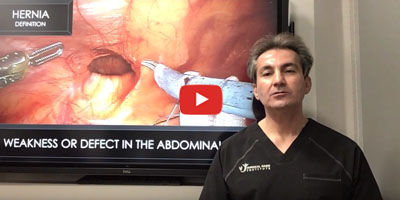 Hernia is a weakness or defect in the abdominal wall musculature. The abdominal wall musculature are designed to protect the intraabdominal structures in the abdominal cavity, therefore if there is a weakness or defect in this protective musculature then the content of the abdomen can protrude into the defect and create a bulge with or without pain, especially during straining, heavy activity or exercise.
Hernia is a weakness or defect in the abdominal wall musculature. The abdominal wall musculature are designed to protect the intraabdominal structures in the abdominal cavity, therefore if there is a weakness or defect in this protective musculature then the content of the abdomen can protrude into the defect and create a bulge with or without pain, especially during straining, heavy activity or exercise.
What are the symptoms of hernia?
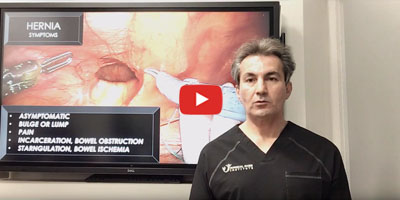 Majority of patients with hernia have no signs or symptoms. Some of the patients are found to have hernia during the routine physical examination by their physicians. Some present with a bulge or lump which could be associated with pain and discomfort especially during straining, heavy activity or exercise. In some patients the bulge could be pushed back into their abdomen easily or disappear while they are lying down. Once the intraabdominal structure inside the hernia defect is entrapped, patient does experience increasing pain and the bulge is not reducible. This hernia is called incarcerated hernia and needs to be fixed as soon as possible otherwise the blood supply to the incarcerated intraabdominal structure will be compromised which leads to strangulation and necrosis. This complication of hernia repair is called strangulated hernia and needs to be addressed as a surgical emergency.
Majority of patients with hernia have no signs or symptoms. Some of the patients are found to have hernia during the routine physical examination by their physicians. Some present with a bulge or lump which could be associated with pain and discomfort especially during straining, heavy activity or exercise. In some patients the bulge could be pushed back into their abdomen easily or disappear while they are lying down. Once the intraabdominal structure inside the hernia defect is entrapped, patient does experience increasing pain and the bulge is not reducible. This hernia is called incarcerated hernia and needs to be fixed as soon as possible otherwise the blood supply to the incarcerated intraabdominal structure will be compromised which leads to strangulation and necrosis. This complication of hernia repair is called strangulated hernia and needs to be addressed as a surgical emergency.
What are the different types of hernia?
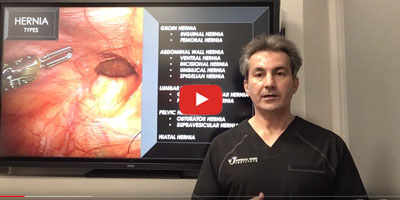 The hernia is a weakness or defect in the musculature. Therefore, it could happen in any location of the abdominal cavity. The hernias in the anterior abdominal wall are called ventral and incisional hernias. The incisional hernia is the result of any surgical incision that weakens the abdominal wall and leads to a weakness or defect in the abdominal wall. We also have defects in the groin region and the hernias in this location called inguinal and femoral hernias. If the defect in the muscle is in the diaphragm then it called hiatal hernia and the defects in the pelvic floor are called pelvic hernias. There are rare hernias in the lumbar regions as well which are lumbar hernias.
The hernia is a weakness or defect in the musculature. Therefore, it could happen in any location of the abdominal cavity. The hernias in the anterior abdominal wall are called ventral and incisional hernias. The incisional hernia is the result of any surgical incision that weakens the abdominal wall and leads to a weakness or defect in the abdominal wall. We also have defects in the groin region and the hernias in this location called inguinal and femoral hernias. If the defect in the muscle is in the diaphragm then it called hiatal hernia and the defects in the pelvic floor are called pelvic hernias. There are rare hernias in the lumbar regions as well which are lumbar hernias.
What is the diastasis recti?
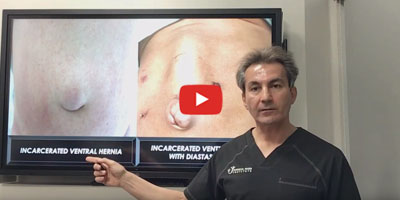 Diastasis recti mean separation of rectus muscles. There are two vertical muscles located in the midline of the anterior abdominal wall (called six packs) that act as the main anterior abdominal wall muscles. These two muscles are covered in strong fibrous sheaths that are attached to each other in the middle. Due to variety of reasons, including obesity, multiple pregnancies and genetic, this midline attachment could be stretched and therefore the rectus muscles are separated from each other (diastasis recti). Most of the patients will see a bulge while they are doing sit up and some patients are complaining of lack of core muscle strength especially during exercise and heavy activity.
Diastasis recti mean separation of rectus muscles. There are two vertical muscles located in the midline of the anterior abdominal wall (called six packs) that act as the main anterior abdominal wall muscles. These two muscles are covered in strong fibrous sheaths that are attached to each other in the middle. Due to variety of reasons, including obesity, multiple pregnancies and genetic, this midline attachment could be stretched and therefore the rectus muscles are separated from each other (diastasis recti). Most of the patients will see a bulge while they are doing sit up and some patients are complaining of lack of core muscle strength especially during exercise and heavy activity.
What is an incisional hernia?
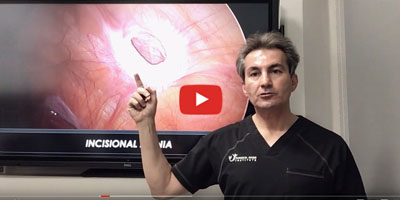 Hernia is a weakness or defect in the abdominal wall musculature. After any types of abdominal surgery involving an incision, there is a chance that incision does not heal appropriately and creates a weakness or defect in the abdominal wall leading to an incisional hernia. There are variety of conditions that increase the chance of developing incisional hernia, including, obesity, diabetes, smoking, postoperative vomiting, coughing and abdominal distension, taking steroid or any immunosuppressive medications, postoperative wound infection and genetic predisposition for poor wound healing.
Hernia is a weakness or defect in the abdominal wall musculature. After any types of abdominal surgery involving an incision, there is a chance that incision does not heal appropriately and creates a weakness or defect in the abdominal wall leading to an incisional hernia. There are variety of conditions that increase the chance of developing incisional hernia, including, obesity, diabetes, smoking, postoperative vomiting, coughing and abdominal distension, taking steroid or any immunosuppressive medications, postoperative wound infection and genetic predisposition for poor wound healing.
What is the importance of groin hernia in female?
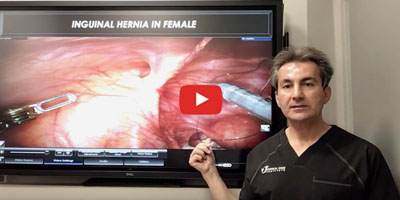 Even though the risk of having hernia in female is much less than male, but hernias are one of the common reasons for chronic abdominal and groin pain in female. Since the diagnosis of the hernia in female is much harder, they usually get misdiagnosed or underdiagnosed. Therefore, it is essential to appreciate the possibility of hernia diagnosis in this group of patients and perform a thorough examination with appropriate diagnostic imaging for early diagnosis and surgical treatment.
Even though the risk of having hernia in female is much less than male, but hernias are one of the common reasons for chronic abdominal and groin pain in female. Since the diagnosis of the hernia in female is much harder, they usually get misdiagnosed or underdiagnosed. Therefore, it is essential to appreciate the possibility of hernia diagnosis in this group of patients and perform a thorough examination with appropriate diagnostic imaging for early diagnosis and surgical treatment.
What are the risk factors for developing hernias?
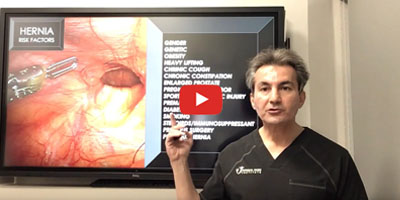 There are conditions that increase the risk of developing hernias.
There are conditions that increase the risk of developing hernias.
These conditions are: Gender (Men & Women), Genetic, Obesity, Heavy Lifting, Chronic Cough, Chronic Constipation, Enlarged Prostate, Pregnancy Hernias And Labor, Sports Or Traumatic Injury, Premature Birth, Diabetes, Smoking, Steroids/Immunosuppressant, Previous Surgery, Previous Hernia
What is the natural history of hernia?
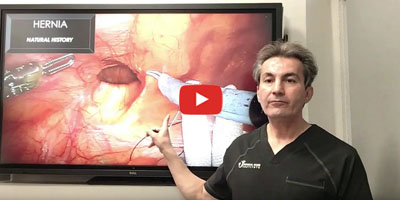 Hernia never heals spontaneously. Only in an infant with umbilical (belly button) hernia, there is a chance that it heals spontaneously and therefore surgeon could wait until they are 5 years old to repair that hernia, unless it is very symptomatic. All other hernias in all age groups just get larger by time and never close spontaneously and therefore, they need to be fixed when they are diagnosed.
Hernia never heals spontaneously. Only in an infant with umbilical (belly button) hernia, there is a chance that it heals spontaneously and therefore surgeon could wait until they are 5 years old to repair that hernia, unless it is very symptomatic. All other hernias in all age groups just get larger by time and never close spontaneously and therefore, they need to be fixed when they are diagnosed.
What is the concept of hernia repair?
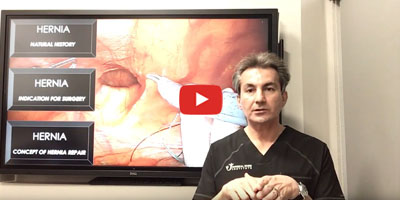 Hernia is a weakness or a defect in the abdominal wall musculature. Therefore, in order to repair the hernia, one can close the hernia defect primarily with sutures and perhaps reinforce the closure with placement of an implant called mesh to strengthen the muscle and prevent the future recurrence of the hernia. There are locations that are not safe or feasible to close the hernia defect and the hernia is closed with placement of the mesh directly over the defect such as groin region. The mesh is a non–absorbable material that increases the foreign body reaction and exaggerates the scar tissue formation which incorporates the mesh into the muscles and creates a very strong tissue at the end of the recovery.
Hernia is a weakness or a defect in the abdominal wall musculature. Therefore, in order to repair the hernia, one can close the hernia defect primarily with sutures and perhaps reinforce the closure with placement of an implant called mesh to strengthen the muscle and prevent the future recurrence of the hernia. There are locations that are not safe or feasible to close the hernia defect and the hernia is closed with placement of the mesh directly over the defect such as groin region. The mesh is a non–absorbable material that increases the foreign body reaction and exaggerates the scar tissue formation which incorporates the mesh into the muscles and creates a very strong tissue at the end of the recovery.
What are the different techniques for hernia repair?
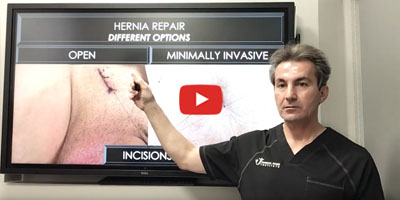 There are two main technique for repair a hernia, open hernia repair vs minimally invasive hernia repair. In open hernia surgery, an incision is made over the hernia defect and the muscle will be closed primarily if it is possible or feasible and then the closure will be reinforced with placement of an implant called mesh to strengthen the closure. In minimally invasive surgery, a few small incisions are made away from the hernia defect and the scope and special instruments are inserted into the abdominal cavity and the hernia defect will be closed primarily if it is feasible and reinforced with mesh to strengthen the muscle. Obviously in minimally invasive surgery, the surgeon eliminates another large incision over the hernia defect which decreases the trauma to the abdominal wall and patient. This less trauma will translates to less pain and swelling after the surgery, faster recovery, less complications and better outcome.
There are two main technique for repair a hernia, open hernia repair vs minimally invasive hernia repair. In open hernia surgery, an incision is made over the hernia defect and the muscle will be closed primarily if it is possible or feasible and then the closure will be reinforced with placement of an implant called mesh to strengthen the closure. In minimally invasive surgery, a few small incisions are made away from the hernia defect and the scope and special instruments are inserted into the abdominal cavity and the hernia defect will be closed primarily if it is feasible and reinforced with mesh to strengthen the muscle. Obviously in minimally invasive surgery, the surgeon eliminates another large incision over the hernia defect which decreases the trauma to the abdominal wall and patient. This less trauma will translates to less pain and swelling after the surgery, faster recovery, less complications and better outcome.
What is the difference between robotic and laparoscopic hernia repair?
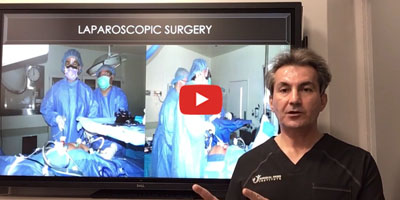 In minimally invasive surgery, a few small incisions are made away from the hernia defect and the scope and special instruments are inserted into the abdominal cavity and the hernia defect will be closed primarily if it is feasible and reinforced with mesh to strengthen the muscle. Obviously in minimally invasive surgery, the surgeon eliminates another large incision over the hernia defect which decreases the trauma to the abdominal wall and patient. this less trauma will translate to less pain and swelling after the surgery, faster recovery, less complications and better outcome. The minimally invasive hernia surgery includes laparoscopic surgery and robotic hernia repair. In laparoscopic surgery, surgeon stand above the patients and holds the special rigid laparoscopic instruments and looking at the monitor perform the surgical tasks and hernia repair. In robotic surgery, the special wristed robotic instruments are attached to the robotic arms and surgeon sits away from the patient behind a console and looks at the monitor and holds the joysticks and the robotic platform translates the movement of the surgeon`s hands to the tip of the robotic instruments to perform the surgical tasks. The robotic set up is more complex and requires expertise and experience but the instrumentation and visualization are superior even though the results are comparable between robotic and laparoscopic surgery in literature.
In minimally invasive surgery, a few small incisions are made away from the hernia defect and the scope and special instruments are inserted into the abdominal cavity and the hernia defect will be closed primarily if it is feasible and reinforced with mesh to strengthen the muscle. Obviously in minimally invasive surgery, the surgeon eliminates another large incision over the hernia defect which decreases the trauma to the abdominal wall and patient. this less trauma will translate to less pain and swelling after the surgery, faster recovery, less complications and better outcome. The minimally invasive hernia surgery includes laparoscopic surgery and robotic hernia repair. In laparoscopic surgery, surgeon stand above the patients and holds the special rigid laparoscopic instruments and looking at the monitor perform the surgical tasks and hernia repair. In robotic surgery, the special wristed robotic instruments are attached to the robotic arms and surgeon sits away from the patient behind a console and looks at the monitor and holds the joysticks and the robotic platform translates the movement of the surgeon`s hands to the tip of the robotic instruments to perform the surgical tasks. The robotic set up is more complex and requires expertise and experience but the instrumentation and visualization are superior even though the results are comparable between robotic and laparoscopic surgery in literature.
How do we repair the inguinal hernia robotically or laparoscopically?
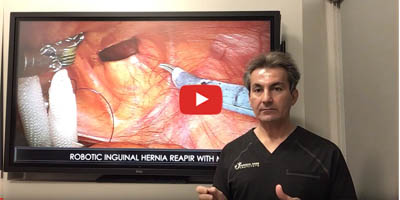 Patient is placed under general anesthesia, and three small incisions are made in the abdominal wall and the instruments are inserted. A transverse incision is made in the peritoneum behind the hernia defect and a pre-peritoneal space is created and a mesh is inserted behind the muscle inside the pocket and secure to the tissue with suture and bio glue and then the peritoneal defect is closed primarily with suture to completely bury the mesh behind the muscle. This operation is out-patient and patient will be discharged home the same day.
Patient is placed under general anesthesia, and three small incisions are made in the abdominal wall and the instruments are inserted. A transverse incision is made in the peritoneum behind the hernia defect and a pre-peritoneal space is created and a mesh is inserted behind the muscle inside the pocket and secure to the tissue with suture and bio glue and then the peritoneal defect is closed primarily with suture to completely bury the mesh behind the muscle. This operation is out-patient and patient will be discharged home the same day.
What is the long-term outcome of robotic inguinal hernia repair?
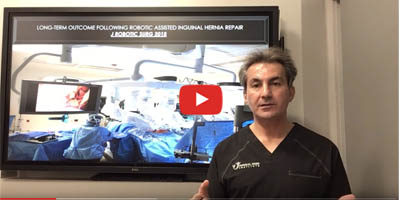 This outcome study was published in the journal of robotic surgery recently and was the result of evaluating the outcome of 82 of my patients who underwent hernia repair. The results were outstanding which showed very minimal risk and recurrence rate for robotic assisted inguinal hernia repair.
This outcome study was published in the journal of robotic surgery recently and was the result of evaluating the outcome of 82 of my patients who underwent hernia repair. The results were outstanding which showed very minimal risk and recurrence rate for robotic assisted inguinal hernia repair.
What is minimally invasive surgery?
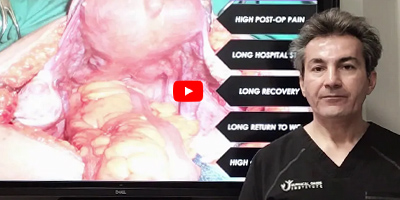 Minimally invasive surgery is a way of performing the surgical tasks with less trauma to the patient and therefore it decreases postoperative pain, lessens the postoperative hospital stay and recovery, decreases the postoperative complications and improves the patient outcome. The concept of the minimally invasive surgery can apply to all surgical disciplines. In order to perform minimally invasive abdominal surgery, the surgeon makes multiple small incisions (instead of large abdominal incision in the open surgery) and places small ports inside the abdominal cavity. Then CO2 is insufflated into the abdomen to inflate the abdominal cavity and allow the surgeon to see the intraabdominal structures easily and perform the necessary surgical tasks. A scope is then inserted into the abdomen through one of the ports. This scope is connected to the video camera which transfers the video to a monitor for surgeon and the rest of the surgical team to view. There are variety of special instruments that allow the surgeon to perform the different surgical tasks. In the abdominal surgery, there are two different types of minimally invasive surgeries, called laparoscopic and robotic surgery. In the laparoscopic surgery, the surgeon and his/her assistant stand next to the patient and place the laparoscopic instruments and scope directly into the abdomen to perform the surgery. In the robotic surgery the special robotic instruments are connected to the robotic arms and surgeon sits behind a console away from the patient and move the joysticks. The robotic platform translates the surgeon`s hands movement into the movement of the tip of the special instruments to perform the necessary surgical tasks. The robotic platform offers better visualization and wristed instrumentation and allow the surgeon to perform a very precise operation. Since, in both techniques the entire procedure is done through the small incisions and by eliminating the large open abdominal incision the trauma to the patient is minimized, the post-operative results are comparable.
Minimally invasive surgery is a way of performing the surgical tasks with less trauma to the patient and therefore it decreases postoperative pain, lessens the postoperative hospital stay and recovery, decreases the postoperative complications and improves the patient outcome. The concept of the minimally invasive surgery can apply to all surgical disciplines. In order to perform minimally invasive abdominal surgery, the surgeon makes multiple small incisions (instead of large abdominal incision in the open surgery) and places small ports inside the abdominal cavity. Then CO2 is insufflated into the abdomen to inflate the abdominal cavity and allow the surgeon to see the intraabdominal structures easily and perform the necessary surgical tasks. A scope is then inserted into the abdomen through one of the ports. This scope is connected to the video camera which transfers the video to a monitor for surgeon and the rest of the surgical team to view. There are variety of special instruments that allow the surgeon to perform the different surgical tasks. In the abdominal surgery, there are two different types of minimally invasive surgeries, called laparoscopic and robotic surgery. In the laparoscopic surgery, the surgeon and his/her assistant stand next to the patient and place the laparoscopic instruments and scope directly into the abdomen to perform the surgery. In the robotic surgery the special robotic instruments are connected to the robotic arms and surgeon sits behind a console away from the patient and move the joysticks. The robotic platform translates the surgeon`s hands movement into the movement of the tip of the special instruments to perform the necessary surgical tasks. The robotic platform offers better visualization and wristed instrumentation and allow the surgeon to perform a very precise operation. Since, in both techniques the entire procedure is done through the small incisions and by eliminating the large open abdominal incision the trauma to the patient is minimized, the post-operative results are comparable.
About hernia surgery?
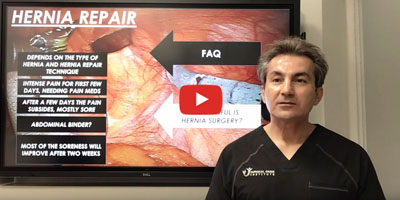 Patients with hernia have many questions prior to the surgery, but two of the most common questions are “how painful is the hernia surgery?” and “is hernia repair permanent?”. This video discusses these common questions in detail.
Patients with hernia have many questions prior to the surgery, but two of the most common questions are “how painful is the hernia surgery?” and “is hernia repair permanent?”. This video discusses these common questions in detail.
What to expect before hernia surgery?
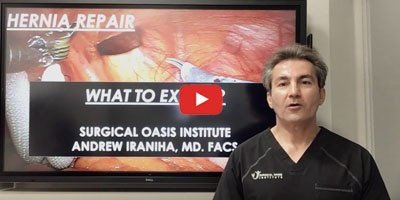 Hernia repair surgery is one of the most common procedures in this country. Patients always have apprehension before any surgical intervention especially when they have minimal information of what they need to expect, before, during and after surgery. This video discusses what to expect before the hernia surgery from the time of consultation until the day of surgery.
Hernia repair surgery is one of the most common procedures in this country. Patients always have apprehension before any surgical intervention especially when they have minimal information of what they need to expect, before, during and after surgery. This video discusses what to expect before the hernia surgery from the time of consultation until the day of surgery.
What to expect the day of hernia surgery?
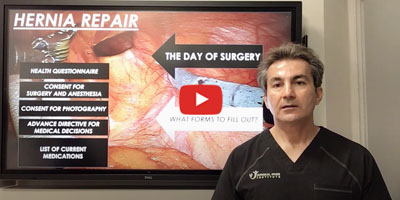 Hernia repair surgery is one of the most common procedures in this country. Patients always have apprehension before any surgical intervention especially when they have minimal information of what they need to expect, before, during and after surgery. This video discusses what to expect the day of hernia surgery from the time of arrival to the surgery center until the end of surgery.
Hernia repair surgery is one of the most common procedures in this country. Patients always have apprehension before any surgical intervention especially when they have minimal information of what they need to expect, before, during and after surgery. This video discusses what to expect the day of hernia surgery from the time of arrival to the surgery center until the end of surgery.
What to expect after hernia surgery?
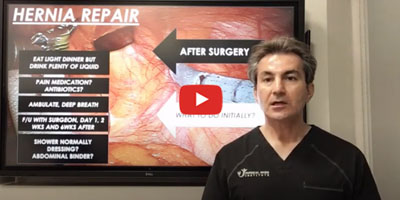 Hernia repair surgery is one of the most common procedures in this country. Patients always have apprehension before any surgical intervention especially when they have minimal information of what they need to expect, before, during and after surgery. This video discusses what to expect after the hernia surgery from the first day to the end of recovery.
Hernia repair surgery is one of the most common procedures in this country. Patients always have apprehension before any surgical intervention especially when they have minimal information of what they need to expect, before, during and after surgery. This video discusses what to expect after the hernia surgery from the first day to the end of recovery.
What are the possible complications of the hernia surgery?
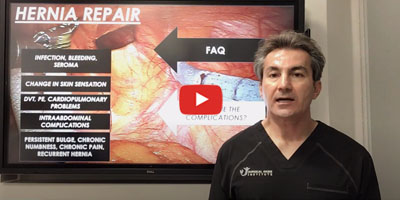 Hernia repair surgery is not an operation without a risk. Even though the risks are extremely minimal but there are potential complications that need to be discussed with patient prior to the hernia repair surgery. This video goes over the potential complications after hernia repair surgery.
Hernia repair surgery is not an operation without a risk. Even though the risks are extremely minimal but there are potential complications that need to be discussed with patient prior to the hernia repair surgery. This video goes over the potential complications after hernia repair surgery.
What you need to know about inguinal hernia repair?
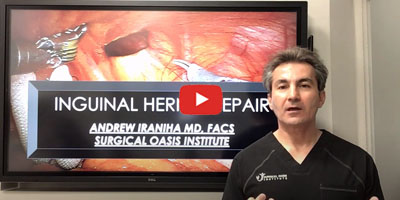 Inguinal hernia is a weakness or defect in the musculature of the groin region. It can be congenital or acquired. They usually present as a bulge in the groin region, with on and off pain and discomfort especially during activity and straining. There are many different techniques for repairing the inguinal hernias. This video goes over everything you need to know about the inguinal hernia repair.
Inguinal hernia is a weakness or defect in the musculature of the groin region. It can be congenital or acquired. They usually present as a bulge in the groin region, with on and off pain and discomfort especially during activity and straining. There are many different techniques for repairing the inguinal hernias. This video goes over everything you need to know about the inguinal hernia repair.
What you need to know about ventral hernia repair?
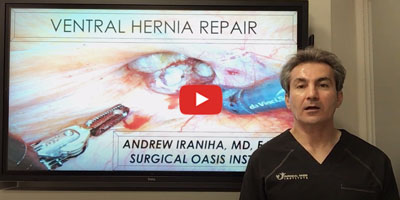 Ventral hernia is a weakness or defect in the anterior abdominal wall musculature. It can be congenital (like most of the umbilical hernias) or acquired (like incisional hernia after any abdominal surgery). They usually present as a bulge in the anterior abdominal wall, with on and off pain and discomfort especially during activity and straining. There are many different techniques for repairing the ventral hernias. This video goes over everything you need to know about the ventral hernia repair.
Ventral hernia is a weakness or defect in the anterior abdominal wall musculature. It can be congenital (like most of the umbilical hernias) or acquired (like incisional hernia after any abdominal surgery). They usually present as a bulge in the anterior abdominal wall, with on and off pain and discomfort especially during activity and straining. There are many different techniques for repairing the ventral hernias. This video goes over everything you need to know about the ventral hernia repair.
Is surgical mesh safe for hernia surgery?
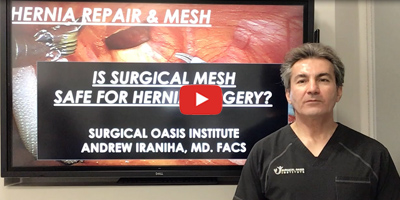 The surgical mesh safety has been an important topic in hernia surgery. There is large amount of data in regards to risks and benefits of surgical mesh in hernia repair surgery and this video discusses everything you need to know about this subject prior to the operation.
The surgical mesh safety has been an important topic in hernia surgery. There is large amount of data in regards to risks and benefits of surgical mesh in hernia repair surgery and this video discusses everything you need to know about this subject prior to the operation.
FAQ about surgical mesh?
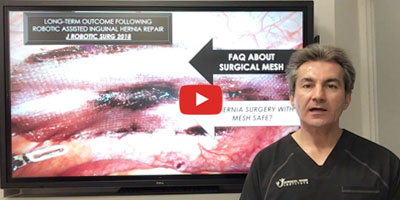 Most of the hernias need to be repaired with placement of mesh. However, there are many questions surrounding the mesh that need to be discussed prior to its application. This video discusses these common questions in detail.
Most of the hernias need to be repaired with placement of mesh. However, there are many questions surrounding the mesh that need to be discussed prior to its application. This video discusses these common questions in detail.
Why do we use mesh in surgery?
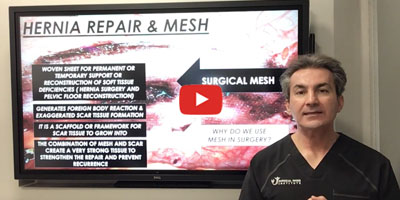 Most of the hernias need to be repaired with placement of mesh. This video discusses why we need to use mesh in surgery.
Most of the hernias need to be repaired with placement of mesh. This video discusses why we need to use mesh in surgery.
What are the problems with mesh implant?
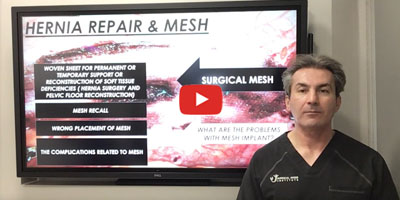 The surgical mesh safety has been an important topic in hernia surgery. There is large amount of data in regards to risks and benefits of surgical mesh in hernia repair surgery and this video discusses the problems related to the mesh implant.
The surgical mesh safety has been an important topic in hernia surgery. There is large amount of data in regards to risks and benefits of surgical mesh in hernia repair surgery and this video discusses the problems related to the mesh implant.
How to minimize the complications of the mesh placement?
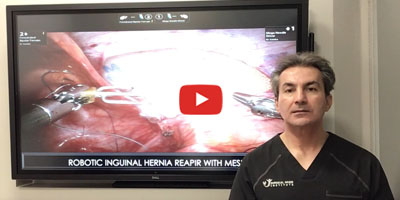 The surgical mesh safety has been an important topic in hernia surgery. There is large amount of data in regards to risks and benefits of surgical mesh in hernia repair surgery and this video discusses the strategies to minimize the complications related to the mesh placement.
The surgical mesh safety has been an important topic in hernia surgery. There is large amount of data in regards to risks and benefits of surgical mesh in hernia repair surgery and this video discusses the strategies to minimize the complications related to the mesh placement.
How can we diagnose the surgical mesh problems?
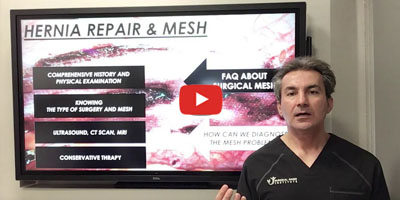 The surgical mesh safety has been an important topic in hernia surgery. There is large amount of data in regards to risks and benefits of surgical mesh in hernia repair surgery and this video answers the common question of how we diagnose the problems related to surgical mesh.
The surgical mesh safety has been an important topic in hernia surgery. There is large amount of data in regards to risks and benefits of surgical mesh in hernia repair surgery and this video answers the common question of how we diagnose the problems related to surgical mesh.
Can surgical mesh migrate or reject?
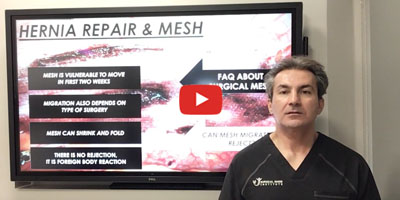 The surgical mesh safety has been an important topic in hernia surgery. There is large amount of data in regards to risks and benefits of surgical mesh in hernia repair surgery and this video discusses whether the mesh can move or reject.
The surgical mesh safety has been an important topic in hernia surgery. There is large amount of data in regards to risks and benefits of surgical mesh in hernia repair surgery and this video discusses whether the mesh can move or reject.
Can surgical mesh be removed?
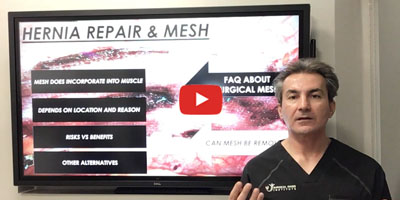 The surgical mesh safety has been an important topic in hernia surgery. There is large amount of data in regards to risks and benefits of surgical mesh in hernia repair surgery and this video answers the common question of the possibility and indications for mesh removal.
The surgical mesh safety has been an important topic in hernia surgery. There is large amount of data in regards to risks and benefits of surgical mesh in hernia repair surgery and this video answers the common question of the possibility and indications for mesh removal.
What are the complications related to mesh implant?
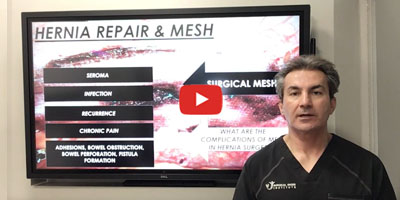 The surgical mesh safety has been an important topic in hernia surgery. There is large amount of data in regards to risks and benefits of surgical mesh in hernia repair surgery and this video discusses some of the most common complications, related to mesh implant.
The surgical mesh safety has been an important topic in hernia surgery. There is large amount of data in regards to risks and benefits of surgical mesh in hernia repair surgery and this video discusses some of the most common complications, related to mesh implant.
What is a mesh?
Mesh is a foreign object that implanted in the site of hernia repair to increase the scar tissue formation and reinforce the strength of the hernia repair with mesh. These material are synthetic or biologic and absorbable or non-absorbable. Depending the type of hernia and variety of other factors, the surgeon determines the need for the mesh and its type.
Why do I need to use mesh for my hernia surgery?
Mesh is used to reinforce the strength of the hernia repair and decrease the possibility of hernia to come back.
Do I always need a mesh?
No. it really depends on the type and size of hernia. Inguinal or groin hernia almost always needs to be repaired with synthetic non-absorbable mesh, but smaller abdominal wall hernias can be fixed without usage of any mesh.

